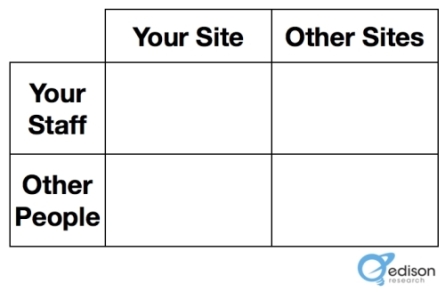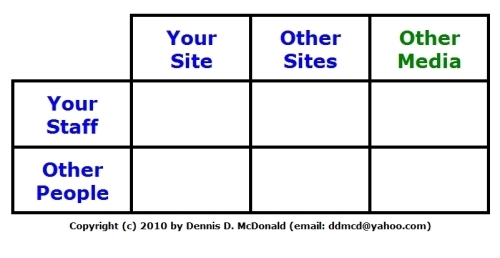Two Simple Organizing Models for Communication Program Planning
Sometimes I need to be whacked on the side of the head to keep things simple. I’ve been looking for a simple way to provide a high level view of the factors that need to be included in a communication strategy that includes new and old media as well as the interaction between internal and external groups. Social media are increasingly important elements but are not the only elements in such strategies, espcially when diverse groups of staff and users need to be included.
One of the best and simplest diagrams I’ve found is described elegantly by Tom Webster of Edison Research in A Simple Matrix For Social Media Engagement:

Working through these categories, as Webster does, provides a focused way to talk about important elements in communication planning.
Still, for some projects there will be an issue with the Edison diagram focusing only on “sites.” In some cases this may be appropriate or it may not. For example, I’ve recently been involved in a series of projects (a government agency, a nonprofit think-tank, and a national research institute) where social media planning has to take into account more traditional web sites and media as well. Keeping the planning process simple has proven to be a challenge.
One reason for this is a factor that Webster identifies: content management. Basically, the content of what gets communicated via the web, social media, and other media needs to be managed so that, where appropriate, consistency exists regarding what is communicated by staff to other people.
This is especially true with large government or private sector programs where many different “touch points” exist between staff and users, customers, or beneficiaries. There can be significant legal, financial, and political implications if inconsistent or inaccurate information is provided to external users. A lack of coordination increases the likelihood that inconsistencies will occur; this is one reason that how “customer service” is managed is becoming an issue as the openness of Federal government programs increases.
Another consideration is that the same set of “subject matter experts” may need to be engaged repeatedly in answering the same questions arising from different communication channels. Making sure the time of such “scarce resources” is handled correctly is a major reason why modern communication planning needs to look across media and why content management has important economic and policy inplications.
Starting with the above Edison model as a basis, this is what I propose as being a more inclusive way to describe the people, processes, technologies, issues, and transactions that both web- and non-web-based communication planning initiatives need to address:

It’s not that different from the model Webster describes, but I’ve found that focusing attention like this can very quickly help a client understand some of the underlying management and technical issues associated with using a wide range of media to communicate with customers, users, and citizens.
What do you think? Is this a useful approach? Or are there any additional factors that you think need to be included in such an initial organizing model?
Copyright (c) 2010 by Dennis D. McDonald



